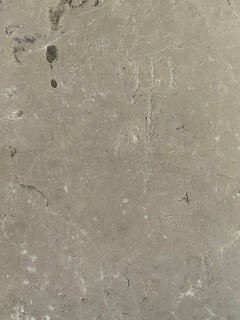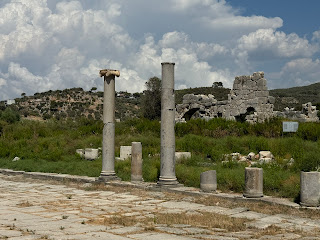Xanthos
Our first encounter was with the theater, a testament to the city's cultural vibrancy. Its tiered seating, a relic of a bygone era, hinted at the capacity of the crowds that once filled its hallowed halls. Şerefe, with a storyteller's flair, wove tales of the city's past, painting a vivid picture of its population.
The theater's design, a testament to ancient engineering, offered a glimpse into the social hierarchy of the time. The VIP seats, a privileged perch, were the lower tiers, they shield from the gaze of the commoners who occupied the upper tiers. The word "protocol," (big ass!) a relic of this ancient setup, echoed the importance of preserving order and hierarchy.
A sarcophagus, shaped like an inverted boat, stood as a silent sentinel near the theater. Its occupant, a wealthy seaman, was forever entombed within this maritime monument.
Nearby, a rock etched with inscriptions in Greek and Lycian, a Rosetta Stone of sorts, offered a glimpse into the linguistic tapestry of the region. These inscriptions, a testament to the enduring power of language, had played a crucial role in deciphering the Lycian language and understanding the rich tapestry of its culture.
The ancient city, a testament to human ingenuity, revealed its secrets. We stumbled upon ancient graffiti, a testament to the human spirit's enduring need for expression. Even the simple act of playing a board game, a timeless pursuit, had left its mark upon the stone. The 3 Stones board game, Şerefe pointed out was a favorite of Alexander the Great.
The Esen Çayı River, a lifeline of the past, beckoned. As we stood at its precipice, Şerefe shared tales of the Lycians' tragic fate, their women and children choosing death over the humiliation of falling into Persian hands. Brutus, the Roman general, had faced a similar dilemma, his soldiers incentivized to rescue these women and children.
The Agora, a bustling marketplace of the past, now stood as a silent witness to the city's vibrant history. We wandered through its ruins, discovering ancient graffiti, a testament to the human spirit's enduring need for expression.
The Byzantine Basilica, a testament to the city's later Christian heritage, stood as a silent sentinel. Though closed to visitors, its presence offered a glimpse into the city's evolution through time. The ancient mosaics, hidden beneath protective layers, whispered tales of a faith that had endured.
Letoon
As we approached Letoon, the ancient sanctuary, its echoes resonated through the air. The temples, guardians of the past, stood as silent sentinels, their stones etched with tales of devotion and faith.
The theater, a colossus of stone, revealed its secrets, its tiered seating a testament to the city's cultural vibrancy. The inscriptions, like puzzle pieces, offered glimpses into the lives of those who had once walked these hallowed grounds.
The Lycian League, a beacon of democracy in an ancient world, had left its mark upon the region. Its principles, a testament to human ingenuity, echoed through the centuries.
Patara
As we continued our journey, the day's heat, a relentless adversary, tested our resolve. Some retreated to the sanctuary of the café, seeking respite from the sun's embrace. Others, driven by a thirst for discovery, ventured into the heart of ancient Patara.
The theater, a marvel of engineering, stood as a testament to the city's cultural significance. Its capacity, a staggering six thousand, hinted at the vibrant life that had once pulsed through its veins. It’s the third theater we saw to the day, speaks volume about the Lycians cultural vibrancy.
The agora, a bustling marketplace of the past, revealed its secrets through the worn stones and the inscriptions etched upon its surface. Supposedly, the nearby palm tree, a symbol of life and renewal, is the birth place of Apollo, the origin to the ancient myths and legends that had intertwined with the city's history.
The day drew to a close, a symphony of history, culture, and natural beauty. As we returned to the Larin Su, a quick devotion with Ben before dinner on Psalm 118:22 illuminates how stones are reused, from temple of Apollo to build the newer church, connecting this to what Jesus said in New Testament and what Peter said in 1 Peter.
After that, a sumptuous feast awaited us, a delectable spread of Turkish delicacies. Philip, our resident sommelier, had carefully selected a collection of fine Turkish wines to complement the meal.
As we savored the flavors and shared stories, the gentle sway of the boat lulled me into a peaceful slumber, a fitting end to a day filled with wonder and discovery.





























No comments:
Post a Comment